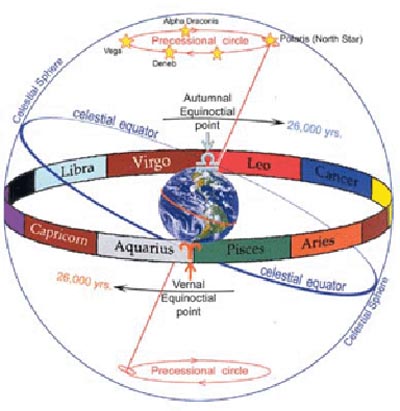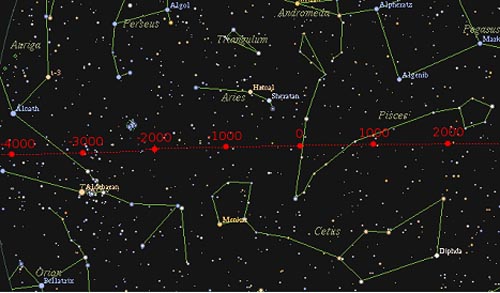ASTROLOGY IN THE BIBLE: ARIES
ASTROLOGY IN THE BIBLE: ARIES
By RALPH ELLIS
There is astrology in the Bible? Readers who know anything about Christianity may be quite confident that the Bible contains no information or veneration of ‘heretical’ beliefs like astrology whatsoever. In fact, surely astrology is Pagan and idolatrous and the complete antithesis of Judaism and Christianity. Is that not so?
Actually, this is not so at all. Yet so ingrained is this common but misguided perception of Judaeo-Christianity, that it may come as a bit of a shock to readers to learn that most if not all of this belief system was once based upon astrology. But this was not necessarily the kind of daily astrology we find in the more trashy magazines of the modern era, but rather a study and veneration of millennial astrology. This long-term study of the heavens is known as precessional astrology, and it is more akin to what we would now call astronomy, as it is based upon a real astronomical event known as the precession of the equinox.

Precession is a real astronomical effect that changes the dominant constellation that rises with the dawn Sun at the vernal equinox (the spring equinox) roughly every 2,140 years. It happens because the earth ‘wobbles’ gyroscopically on its axis, making the axis of the Earth rotate around the constellation of Draco (around the ecliptic pole) once every 25,680 years. But this rotation has a secondary effect, which causes the vernal equinox sunrise (the vernal point) to pass through each constellation in turn, but in a retrograde fashion to normal astrology. Therefore, the Sun takes about 2,140 years to transit each of the twelve constellations. The terminology this celestial motion generates is as follows:
• The long 25,680 year period of time is called the Great Year.
• The shorter period of 2,140 years is known as the Great Month.
But the constellations are not all of the same size, and so the Great Months are not all of the same duration. The established start-dates for the recent Great Months are as follows (all dates +/- 20 years or so):
Taurus 4300 BC (bulls)
Aries 1750 BC (sheep)
Pisces 10 AD (fish)
Aquarius 2550 AD (water)
If we are to discover any references to astrology within the Bible, the first change in the constellations in which we might find that evidence happened in about 1750 BC, when Taurus (the bull) turned into Aries (the ram). Remember that this millennial movement of the Sun through the constellations is a real astronomical event, as can be seen on the following image from a planisphere, where the path of the Sun is marked in red. The numbers here are thousands of years either side of our normal year zero. As can be seen, in about 1800 – 1700 BC, the vernal equinox sunrise was moving away from Taurus (the bull) and towards Aries (the sheep).

But how does all of this fit into the biblical storyline? Where does the Torah mention the vernal equinox? The first clue to biblical astrology being a reality, is that the biblical patriarchs of this very same era became known as ‘shepherds’, just as the Great Month moved from Taurus (bulls) to Aries (sheep). Was this merely a coincidence, because these people were poor shepherds who looked after sheep? Actually, no, and we know this because the change in terminology was both widespread and consistent throughout biblical history. We also know this because Abraham, the first of these biblical ‘shepherds’ was hardly a poverty-stricken nomad with a few flea-bitten goats. The Torah and Josephus Flavius’ accounts of this era say of Abraham:
And when Abram heard that his brother was taken captive, he armed his trained servants, born in his own house, who numbered three hundred and eighteen, and pursued them unto Dan. Gen 14:14
And what did … our forefather Abraham do? Did he avenge the insult by force of arms? Yet he had three hundred and eighteen army officers under him and an immense army under each of them. Jewish War 5:9:4
Hmm, so in the biblical and historical records, Abraham had an army with 318 commanders, and if each commander was a centurion then Abraham’s army numbered 31,800. Now that is quite an army for a poverty-stricken shepherd with a few flea-bitten goats, so why do we have these contradictory accounts? The answer is that in addition to the biblical patriarchs, the Hyksos pharaohs of Egypt were likewise known as the Shepherd Kings, and for the very same reason. And since Abraham was a ‘shepherd’ who controlled such a vast army some 30,000 strong, perhaps he was actually a Hyksos leader. Some Egyptologists have questioned whether ‘Hyksos’ does indeed mean ‘Shepherd’, and thus questioned the obvious connection between the Hyksos pharaohs and the biblical Patriarchs. The translation was originally made by Manetho, a 3rd century BC Egyptian historian, and yet we can be fairly sure that Manetho was correct because ‘Hyksos’ is spelt with the shepherd’s crook.

In addition to these historical ‘shepherds’ we have many other conversions to sheep veneration within this region – kings who were born during the Age of Aries – and these include Alexander the Great and Pharaoh Ptolemy III, who both wore the horns of a ram (Aries) in their hair. They did so not because a ram is a masculine animal, but because they realised that they had been born in the Great Month of Aries, and were therefore Kings of Aries (or Shepherd Kings). This transfer of cosmic veneration from bulls to sheep was also why Gilgamesh, the great Sumerian hero-figure, killed the Bull of Heaven (Taurus).

READ MORE: HERE
These articles were extracted from the books:
Cleopatra to Christ
King Jesus
Mary Magdalene, Princess of Orange
Jesus, King of Edessa
About the Author:
Ralph Ellis is author of Cleopatra to Christ, King Jesus, Mary Magdalene, Princess of Orange. All are available on iPad, Kindle, or Nook. Paperback copies available from Adventures Unlimited of Illinois. See: http://www.edfu-books.com/
